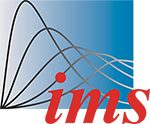Abstract
There is increasing interest in the problem of nonparametric regression with high-dimensional predictors. When the number of predictors $D$ is large, one encounters a daunting problem in attempting to estimate a $D$-dimensional surface based on limited data. Fortunately, in many applications, the support of the data is concentrated on a $d$-dimensional subspace with $d\ll D$. Manifold learning attempts to estimate this subspace. Our focus is on developing computationally tractable and theoretically supported Bayesian nonparametric regression methods in this context. When the subspace corresponds to a locally-Euclidean compact Riemannian manifold, we show that a Gaussian process regression approach can be applied that leads to the minimax optimal adaptive rate in estimating the regression function under some conditions. The proposed model bypasses the need to estimate the manifold, and can be implemented using standard algorithms for posterior computation in Gaussian processes. Finite sample performance is illustrated in a data analysis example.
Citation
Yun Yang. David B. Dunson. "Bayesian manifold regression." Ann. Statist. 44 (2) 876 - 905, April 2016. https://doi.org/10.1214/15-AOS1390
Information





